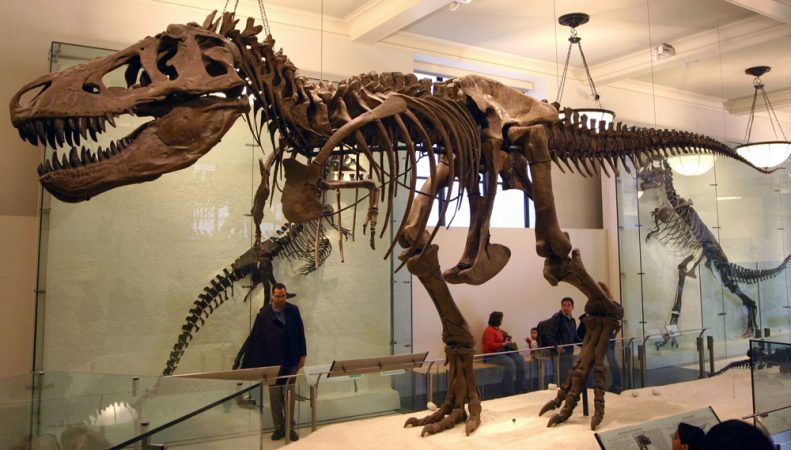Dino-sized poop
Ewww: Scientists use poop from living animals to estimate the size of dung dropped by T. rex and other dinos
By Sid Perkins

How big was dinosaur poop?
This may seem like a disgusting question. And because dinosaurs died out more than 65 million years ago, many people might think the question isn’t important. But scientists use fossil dung to learn a lot about ancient creatures and where they lived.
A new analysis of an old, large piece of dinosaur poop finds it’s possible that Tyrannosaurus rex was the source of the deposit. The scientists used smelly droppings from living wild animals to estimate the size of T. rex’s — and other dinos’ — dung.
Scientists refer to fossil dung as coprolites (KAH pra leitz). In the 1990s, a researcher discovered a very large coprolite in Saskatchewan, a Canadian province just north of Montana and North Dakota. This hunk of fossilized feces was about 2.4 liters. That’s the combined volume of both a 2-liter bottle of soda and a 355-milliliter (20-ounce) bottle. Scientists who studied the coprolite estimated that bone fragments made up between one-third and one-half of the 44-centimeter-long (nearly a foot and a half) piece of poop. That’s a sure sign it came from a predator or a scavenger.
The scientists who discovered the fossil proposed that a Tyrannosaurus rex had dropped it. This large meat-eating dinosaur had bone-crushing teeth the size of bananas. Those scientists offered one big reason for picking this dino as the dung’s source: T. rex was the only large meat-eater known to be living in the region when the poop was dropped.
But not all scientists were totally convinced. Among them: Karl Flessa. He’s a paleontologist, or a scientist who studies fossils, at the University of Arizona in Tucson. Recently, his team decided to investigate further, by studying poop from living animals. The researchers compared the weight of many modern species of mammals and birds with the size of the feces each typically produces.
The scientists collected samples at zoos and wild animal parks from 11 species. These included camels, bears, ostriches and rhinos. “Officially, rhino poop was the worst smelling of them all!” notes team member Amber Struthers. She’s a science teacher at Mountain Sky Middle School in Phoenix. The team also used dung data that other scientists had reported for another 86 species, including creatures from the size of mice to elephants.
The largest dinosaurs were much larger than an elephant. In fact, only the biggest whales living today are larger than the biggest dinosaurs. Flessa’s team applied mathematics to data about poop from living animals to estimate how big the dung from ancient creatures, even huge dinosaurs, might have been.
Those calculations indicate that the 2.4-liter coprolite is about the size a T. rex could have dropped. The new analyses suggest that an even bigger coprolite discovered in Canada could have been made by a larger cousin of T. rex. The volume of that fossil dung: a whopping 6 liters.
“The team’s approach sounds reasonable to me,” says James Farlow. He’s a vertebrate paleontologist at Indiana University-Purdue University in Fort Wayne, Ind.
“This is a great approach,” says Karen Chin. She’s a paleontologist at the University of Colorado in Boulder. She is also a coprolite expert. In fact, it was her team that first described the 2.4-liter dino poop in a scientific paper. She and another team later described the 6-liter coprolite, which was also filled with bone chips.
The new research doesn’t prove a T. rex made the 2.4-liter coprolite, says Chin. But this dino had been living in the area when that poop was dropped. Other large meat-eaters might have also lived there at the time. However, fossils have not yet been found to confirm they did. So for now, Chin says, T. rex is the best suspect.
And whoa: Some dino droppings might have been substantially larger than the coprolites Chin described.
Researchers have estimated that T. rex probably weighed between 5.4 and 6.3 metric tons. That’s slightly larger than today’s average elephant. But an even bigger creature roamed in parts of South America between 94 million and 97 million years ago.
Called Argentinosaurus, it could have weighed about 74 metric tons, scientists estimate. That’s more than 13 elephants! This mammoth long-necked, plant-eating dino probably shed as much as 15 liters of dung at one time, Flessa’s team calculates. That would be enough to fill more than seven 2-liter bottles.
“When most people hear that I study dinosaur poop, they think ‘That’s cute’,” says Chin. But it’s also serious business, she adds. Coprolites can reveal a lot about an animal’s environment. The contents of a coprolite show what a dinosaur ate. And because some fossil poop contains traces of preserved muscle, scientists can calculate how quickly a dinosaur’s digestive system broke down food, says Chin. Finally, because some coprolites have traces of burrows in them, paleontologists know that creatures such as dung beetles and snails were dining on poop long ago, just as their cousins do today.
Power Words
coprolite Fossilized feces. The word coprolite, in Greek, means “dung stones.” Coprolites are very important because they can provide direct evidence of what ancient creatures ate.
fossil Any preserved remains or traces of ancient life. There are many different types of fossils: The bones of dinosaurs are fossils, as are their footprints. Even pieces of dinosaur poop are fossils.
herbivore A creature that ate mostly or only plants.
paleontologist A scientist who specializes in studying fossils, the remains of ancient organisms.
predator A creature that preys on other animals for most or all of its food.
scavenger A creature that feeds on dead or dying organic matter in its environment. Scavengers include vultures, raccoons, dung beetles and some types of flies.







